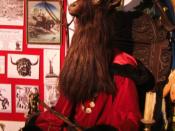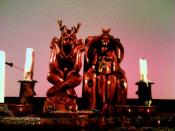The word paganism has its roots in the Latin paganus, meaning country dweller. This is where paganism had its roots, in the ancient rural peoples of long ago. This is evidenced in such artifacts as the Venus of Willendorf and other statues dating well back into the 35th - 10th centuries B.C. The advent of Christianity effectively removed the majority of paganistic icons and tradition from Western Europe. In more recent times there has been an insurgence of past beliefs, and with this the belief by some that many of the religious deities of the past are actually representations of two central gods, nothing more than various versions of one God and Goddess. This theory is very popular among followers of neo-pagan faiths.
Diana, Pan, Isis, Hermes, Hera, Apollo, Athena, God and/or Goddess, all of these forms and hundreds of others are worshipped today. Deity worship, for the pagan, is a personal choice, some choosing monotheism, others dual theism, while still others choose the path of polytheism.
Modern followers of the god Dionysus generally choose the latter, following many of the Hellenistic traditions. This in and of itself is not as popular in North America as it is in Europe where much of what is called modern witchcraft and gypsy religion is actually old beliefs still in use. For the last thirty years or so there has been a growing number of neopagans who define themselves as being Wiccan.
Wicca is a modern, loosely tied together version of many pagan faiths. Scott Cunningham, in his book Wicca: a Guide for the Solitary Practitioner defines Wicca as: "A contemporary Pagan religion with spiritual roots in Shamanism and the earliest expressions of reverence of nature. Among its major motifs are: reverence for the Goddess and the God; reincarnation, magic, ritual observances of...


